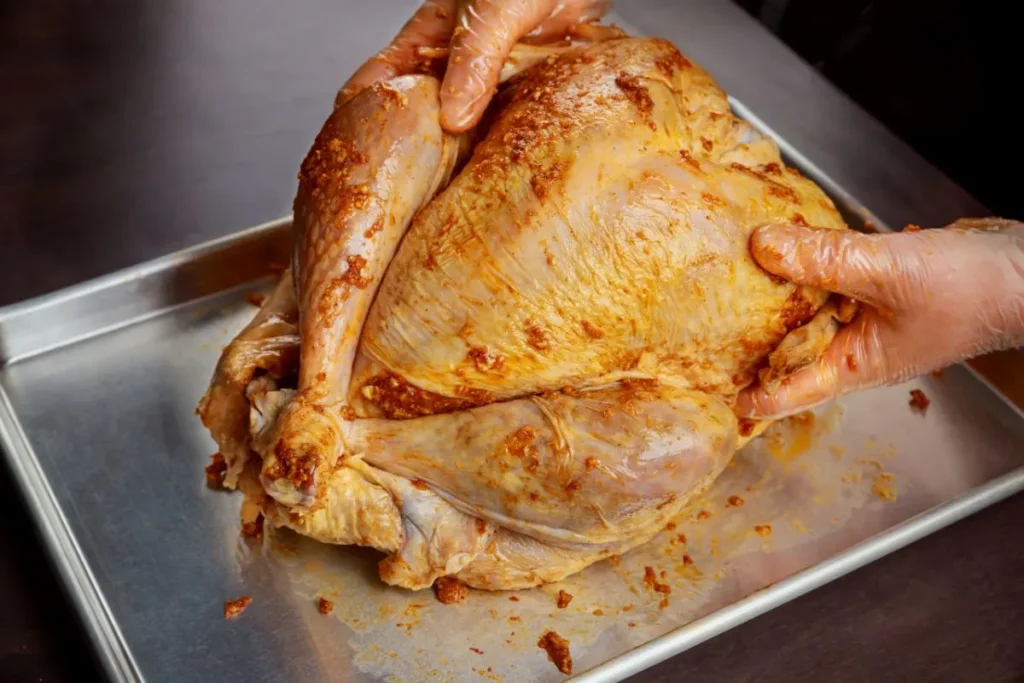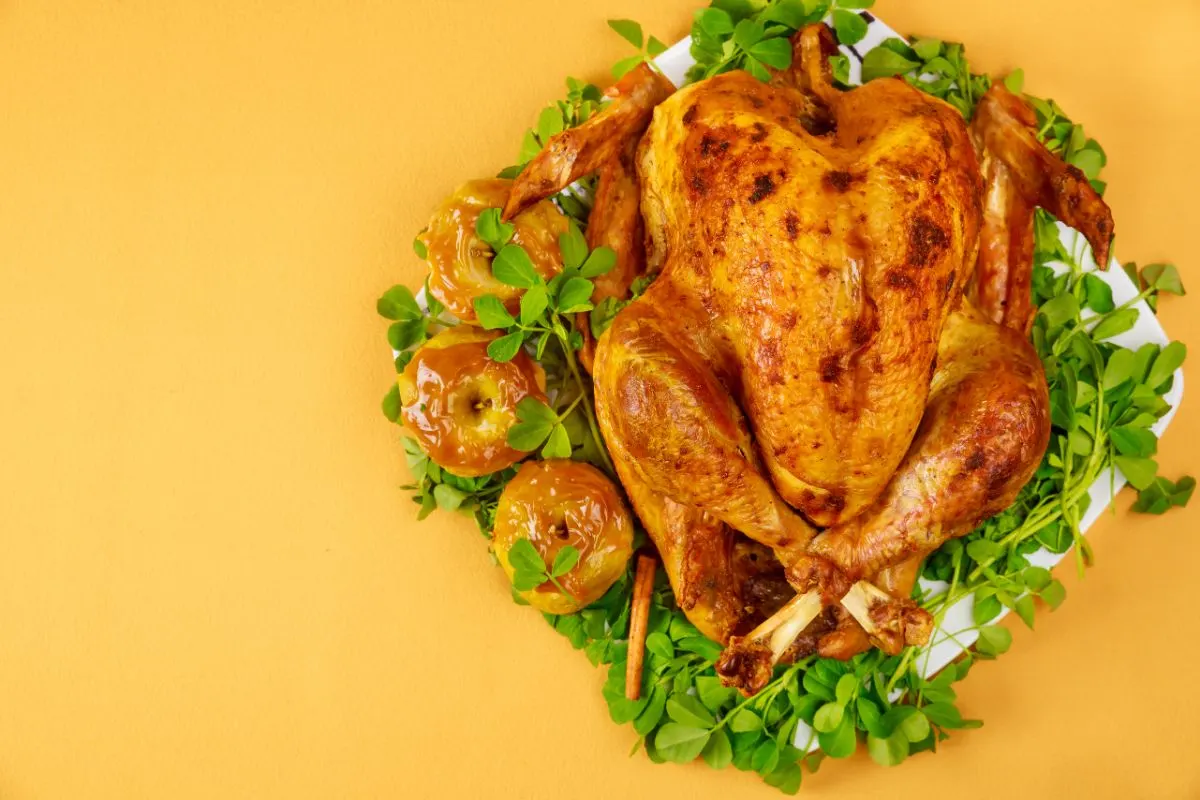Master the art of cooking a moist and flavorful roaster oven turkey with our step-by-step guide.
Introduction
Cooking a turkey in a roaster oven is a convenient, effective method that results in a juicy, flavorful bird. Unlike a conventional oven, a roaster oven is compact, efficient, and frees up space for preparing other dishes. Therefore, it is a fantastic choice for busy holiday meals or when juggling multiple recipes. Whether you’re planning for a holiday feast or simply want to master the art of turkey roasting, this guide will walk you through every step. From selecting the perfect turkey to carving it like a pro, you’ll find all the tips and tricks you need for success.
Moreover, roaster ovens have become a staple in many kitchens due to their versatility. These appliances are ideal for cooking large meals without monopolizing your conventional oven. This guide will focus on the nuances of preparing turkey in a roaster oven, offering expert tips, step-by-step instructions, and answers to common questions to ensure your success.
Table of Contents
Benefits of Using a Roaster Oven for Turkey Preparation
Roaster ovens offer several advantages that make them an excellent choice for cooking turkey:
Space Efficiency
A roaster oven frees up your conventional oven for side dishes and desserts, allowing for better meal coordination during busy holidays. This means you can prepare stuffing, pies, or casseroles simultaneously without worrying about juggling oven racks. Consequently, your holiday meal preparation becomes smoother and less stressful.
Energy Savings
Roaster ovens typically use less energy than a standard oven, making them an eco-friendly choice. They preheat quickly and maintain a consistent temperature, which can save both time and electricity. Additionally, this efficiency makes them ideal for anyone looking to reduce their energy consumption without sacrificing cooking quality.
Moisture Retention
The enclosed cooking environment helps retain moisture, resulting in a juicier turkey. Unlike a conventional oven, which can dry out the meat, a roaster oven traps steam and natural juices to enhance the bird’s flavor and tenderness. As a result, your turkey will be tender, flavorful, and sure to impress your guests.
Portability
Roaster ovens are lightweight and portable, making them ideal for use in small kitchens or outdoor settings. For instance, if you’re hosting a backyard Thanksgiving or preparing meals in a limited space, a roaster oven can be a game-changer.
Ease of Use
Roaster ovens simplify the cooking process with fewer temperature fluctuations, easy-to-use controls, and minimal monitoring requirements. Therefore, these features make it a great option for beginners and seasoned cooks alike, ensuring a hassle-free cooking experience.
Selecting the Best Turkey for Roaster Oven Cooking
When it comes to choosing the perfect turkey for your roaster oven, here are the key considerations:
Size Matters
Ensure the turkey fits comfortably in your roaster oven. There should be enough space for proper air circulation around the bird. Most standard roaster ovens can accommodate turkeys weighing up to 20 pounds, but always check the manufacturer’s specifications. Moreover, having the right size ensures even cooking and optimal results.
Calculating Portion Sizes
When planning portion sizes, consider about 1.5 pounds of turkey per person for generous servings. For smaller gatherings, a 10-12 pound turkey is ideal, while larger feasts may call for a 16-20 pound bird. Thus, careful planning ensures everyone at the table has enough to enjoy.
Fresh vs. Frozen
Both fresh and frozen turkeys can deliver excellent results. If you choose a frozen turkey, make sure it is fully thawed before cooking. A fresh turkey often has a slightly better texture but requires timely purchase to ensure freshness.
Key Considerations
- Fresh Turkeys: Usually have a shorter shelf life but don’t require thawing, which can save time during preparation.
- Frozen Turkeys: More widely available and cost-effective but require advance planning for thawing, ensuring readiness for cooking.
Quality Considerations
Opt for a turkey labeled as “Grade A” for the highest quality. Organic, free-range, or heritage turkeys may offer superior flavor and tenderness, but they often come at a higher price point. Therefore, selecting a high-quality bird can elevate the overall dining experience.
Additional Factors
- Pre-brined Options: Pre-brined turkeys save time and enhance flavor, eliminating the need for additional seasoning.
- Injected Turkeys: Some brands inject turkeys with a solution of broth, salt, and seasoning for added moisture, simplifying the preparation process.
Thawing Your Turkey for the Roaster Oven
Proper thawing is crucial for even cooking and food safety. Use one of these methods:
Refrigerator Thawing
This is the safest and most reliable method for thawing a turkey:
- Place the turkey in a large pan to catch drips.
- Allow approximately 24 hours for every 4-5 pounds of turkey.
- Ensure the refrigerator temperature is set at or below 40°F (4°C).
For example, a 16-pound turkey will take about four days to thaw fully in the refrigerator. Consequently, planning ahead is essential to ensure the turkey is ready on time.
Cold Water Thawing
This method is faster but requires more attention:
- Submerge the turkey (in its original packaging) in cold water.
- Change the water every 30 minutes to maintain a consistent temperature.
- Allow about 30 minutes per pound.
For a 16-pound turkey, this method will take about 8 hours. However, always cook the turkey immediately after thawing to prevent bacterial growth.
Emergency Thawing Tips
If you’re short on time, consider purchasing a smaller, fresh turkey or pre-thawed turkey from your local butcher or supermarket. Avoid microwave thawing for a large turkey, as it can lead to uneven thawing and partially cooked spots. Therefore, planning alternative solutions can save time in a pinch.
Preparing the Turkey

Preparation is key to achieving the best results. Follow these steps:
Cleaning the Turkey
- Remove Giblets: Check both the neck and body cavities for giblets and remove them.
- Rinse and Dry: Rinse the turkey inside and out with cold water and pat dry with paper towels. This ensures the turkey is clean and ready for seasoning.
Seasoning
A well-seasoned turkey is a flavorful turkey. Consider these options:
Basic Seasoning
- Rub the turkey with olive oil or melted butter.
- Season generously with salt, pepper, and garlic powder. This simple yet effective method enhances the natural flavors of the bird.
Herb Blend
- Combine rosemary, thyme, sage, and parsley for an aromatic rub. Thus, your turkey will have a delightful herbal fragrance and taste.
Citrus Infusion
- Stuff the cavity with halved lemons, oranges, and fresh herbs for a bright, zesty flavor. Consequently, this method adds a refreshing twist to traditional turkey recipes.
Spiced Rubs
For a unique twist, consider using a Cajun or barbecue rub to add a flavorful kick to your turkey. Therefore, experimenting with spices can cater to different taste preferences.
Step-by-Step Guide to Roasting Turkey in a Roaster Oven
Equipment Checklist
- Roaster oven with a lid
- Rack to elevate the turkey
- Meat thermometer
- Basting brush
Having the right equipment ensures a smooth cooking process and optimal results.
Step-by-Step Instructions
- Preheat the Roaster Oven: Set it to 325°F (163°C) and let it preheat.
- Prepare the Turkey: Place the turkey on the rack inside the roaster oven, breast side up. This positioning ensures even cooking and proper heat distribution.
- Add Aromatics: Add onions, celery, carrots, and herbs to the cavity or the bottom of the roaster for added flavor.
- Cover and Cook: Cover the roaster oven and cook the turkey. Allow approximately 15 minutes per pound. Therefore, timing is critical to achieving perfectly cooked meat.
- Monitor the Temperature: Insert a meat thermometer into the thickest part of the thigh. The turkey is done when it reaches 165°F (74°C). Consequently, this ensures the turkey is safe to eat and cooked to perfection.
Cooking Times
- 12-pound turkey: ~3 hours
- 16-pound turkey: ~4 hours
- 20-pound turkey: ~5 hours
However, always rely on the thermometer rather than time alone to confirm doneness.
Basting and Browning
Basting Tips
- Begin basting after the first hour and repeat every 30 minutes using the turkey’s juices or melted butter. This process keeps the meat moist and flavorful.
- Use a silicone basting brush for even application, ensuring all parts of the turkey are covered.
Achieving Crispy Skin
- If your roaster oven has a browning feature, use it during the last 30 minutes of cooking.
- Alternatively, transfer the turkey to a conventional oven at 375°F (190°C) for 15-20 minutes for additional crispiness. Consequently, these techniques result in a beautifully golden, crispy skin.
Resting and Carving
Resting
Let the turkey rest for 20-30 minutes after cooking. This step allows the juices to redistribute, resulting in a moist and tender bird. Therefore, skipping this step can lead to dry meat.
Carving
Follow these steps for professional-level carving:
- Remove the Legs: Cut through the joints to separate the drumsticks and thighs.
- Slice the Breast: Use a sharp knife to carve thin, even slices. Therefore, each piece will be easy to serve and enjoy.
- Arrange on a Platter: Place the carved pieces on a serving platter with garnish for an elegant presentation.
Troubleshooting Common Issues
Dry Turkey
If the turkey turns out dry:
- Use a gravy or sauce to enhance moisture.
- Consider brining the turkey before roasting next time. Consequently, these methods can help salvage the dish.
Uneven Cooking
- Ensure the turkey is fully thawed.
- Use a meat thermometer to check multiple spots. Therefore, taking these precautions ensures consistent results.
Nutritional Information
| Nutrient | Amount per 100g |
|---|---|
| Calories | 170 |
| Protein | 28g |
| Fat | 6g |
| Carbohydrates | 0g |
| Sodium | 70mg |
| Cholesterol | 75mg |
Frequently Asked Questions (FAQ)
How long do you cook a turkey in the roaster?
Cooking times vary based on weight. Allow approximately 15 minutes per pound at 325°F (163°C). Always verify the internal temperature with a meat thermometer. Consequently, these steps ensure a perfectly cooked turkey. Discover how to perfectly cook a turkey in a roaster oven, from timing and techniques to safety tips, for a juicy, tender, and delicious meal.
Do I put water in the bottom of a roaster for turkey?
No, adding water is unnecessary. The turkey will produce its own juices during cooking, ensuring a moist result. Therefore, this step simplifies the cooking process.
Should I roast my turkey at 325 or 350?
325°F (163°C) is ideal for even cooking and moisture retention. Higher temperatures may dry out the turkey. Consequently, sticking to 325°F yields the best results.
Is it better to cook turkey in a roaster oven or regular oven?
Both methods can produce excellent results. A roaster oven retains moisture effectively and frees up conventional oven space, while a regular oven may provide better browning. Therefore, the choice depends on your priorities and available equipment.
Conclusion
Cooking a turkey in a roaster oven is an efficient and stress-free way to achieve a moist, flavorful bird. By following these guidelines, you’ll ensure a successful centerpiece for your holiday meal. Therefore, embrace this method for a hassle-free and delicious turkey. Happy roasting!

